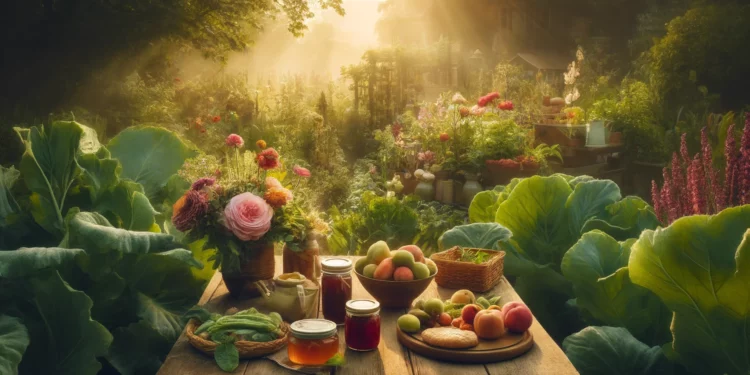This website contains affiliate links. Some products are gifted by the brand to test. As an Amazon Associate, I earn from qualifying purchases. The content on this website was created with the help of AI.
Dive into the rewarding world of homesteading with our guide on sustainable living homestead skills. From lush gardens to DIY projects, discover how Sarah and James transformed their dream into reality, creating a green oasis in their backyard. Learn essential homesteading skills, gardening tips, and kitchen self-sufficiency to embark on your own journey toward a sustainable, fulfilling lifestyle.
Imagine waking up to birds chirping and fresh country air greeting you. You’re completely self-sufficient. This dream is real for homesteaders who live sustainably. They grow food, tackle DIY projects, and rely on themselves. Their homestead skills make their lives full and green.
Sarah and James were tired of city life and its demands. They dreamed of a sustainable oasis in their backyard. So, they ventured into homesteading.
They started learning about homesteading with little prior knowledge. They took classes on self-sufficiency tips and sustainable living techniques. They were eager to learn everything they could.
Soon, their hard work paid off, and their homestead thrived. They created a garden, learning homestead gardening strategies to grow organic food. Thanks to Sarah’s green thumb, their garden soon filled with tomatoes, strawberries, and greens.
Sarah and James also worked on many DIY homesteading projects. They built raised beds, compost bins, and a chicken coop. They improved their carpentry skills. Their work inspired friends and neighbors to try homesteading too.
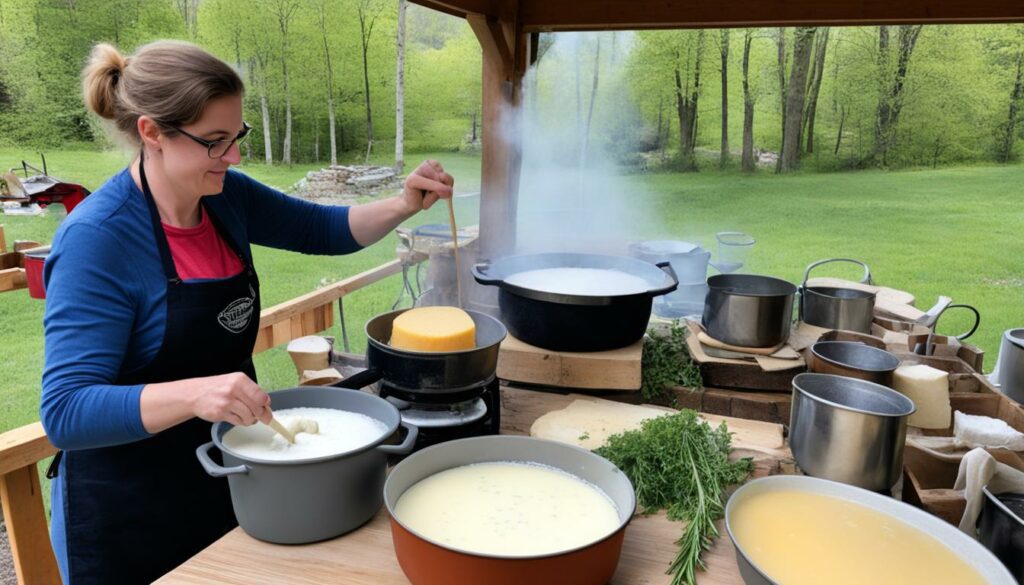
They also became skilled in self-sufficiency in the kitchen. They learned meal planning, cooking from scratch, and preserving food. Their pantry became full of homemade jams, pickles, and canned vegetables.
They began raising chickens for eggs and learning animal husbandry. Later, they added goats for milk and cheese. This made them even more self-sufficient.
Now, Sarah and James’s homestead is a model of sustainability. They’ve done many maintenance projects and live off-grid. They share and trade with neighbors, strengthening their community.
If Sarah and James achieved homesteading success, so can you. By learning homestead skills gradually, you can enjoy sustainable living too.
Key Takeaways:
- Homesteading is a lifestyle that promotes self-sufficiency and sustainable living.
- Learning and developing homestead skills is essential for successful homesteading.
- Mastering homesteading basics such as gardening, DIY projects, and self-sufficiency in the kitchen is crucial.
- Raising livestock and embracing rural living essentials are important aspects of homesteading.
- Building community and bartering with neighbors can enhance the homesteading experience.
Getting Started with Homesteading
Before starting your homesteading journey, learn about homesteading basics and sustainable living techniques. It’s also important to grasp homestead knowledge. A strong understanding will support your self-sufficient lifestyle goals.
Homesteading involves many skills aimed at self-sufficiency and sustainability. Through homesteading techniques, you’ll connect deeply with the land and lessen your environmental impact.
Sustainable living is at the heart of homesteading. The key is to adopt methods that care for the environment and reduce waste. This means using renewable energy, applying permaculture principles, and practicing organic farming.
Essential homestead knowledge is crucial for managing your property. Learning about land care, water conservation, and property upkeep ensures a thriving homestead. Such a homestead sustains both you and the surrounding ecosystem.
Homesteading Resources and Communities
Utilizing resources and communities is very helpful when starting. Online and local groups provide insights, support, and experiences.
Getting involved in homesteading forums, workshops, and farmers’ markets connects you with others. It’s a chance to learn, share, and build a supportive network for your journey.
The Importance of Planning and Goal Setting
Setting clear goals and planning is vital in homesteading. Decide what’s important to you, like food production or energy independence. This will direct your choices and efforts.
- Start Small: Begin with achievable projects that fit your goals and resources. Start a vegetable garden, set up rainwater collection, or compost at home.
- Continual Learning: Keep learning as part of your journey. Look for books, online courses, and workshops to improve your knowledge and skills.
- Prioritizing Self-Sufficiency: Aim for less reliance on outside sources. Focus on skills that let you produce food and power independently.
Starting with a solid grasp of homesteading basics, sustainable living, and homestead knowledge preps you for success. Plot your course, connect with others, and enjoy this adventure towards self-sufficiency and sustainable living.
Homestead Gardening Strategies
Gardening is a must-know for homesteading. It doesn’t matter if your space is small or big. Growing your own food is satisfying and makes you more independent. Using smart gardening methods can make your garden very productive, giving you lots of food.
Container gardening is great for those with little space. You can use pots, buckets, or raised beds to grow plants like herbs and vegetables. Make sure your containers let water out and that you use the right soil and water for your plants.
Companion planting is also really useful. It means growing certain plants together so they help each other out. For example, marigolds keep pests away. Growing tomatoes next to basil can make them taste better too.
Knowing your planting zone is key. Each area has its own climate, which affects plants differently. By choosing the right plants for your zone, your garden will do well.
Gardening Tips for Homesteading
- Research and pick plants that fit your area’s weather and soil.
- Make sure your plants get enough sun, water, and food to stay healthy.
- Keep an eye out for pests and diseases, and deal with them in natural ways.
- Change where you plant things each year to stop pests and diseases.
- Use composting and mulching to make your soil better and save water.
- Keep seeds from your plants for next time. This keeps you independent and saves old plant types.
“Homestead gardening is a journey of self-reliance and connection with nature. By cultivating your own food, you not only increase your self-sufficiency but also gain a deeper understanding of the food system and the natural world around you.”
By following these gardening strategies and tips, you’ll have a rich garden. This not only feeds your family but also supports a green lifestyle. Enjoy the process of growing your food and enjoy the benefits of living off your land.
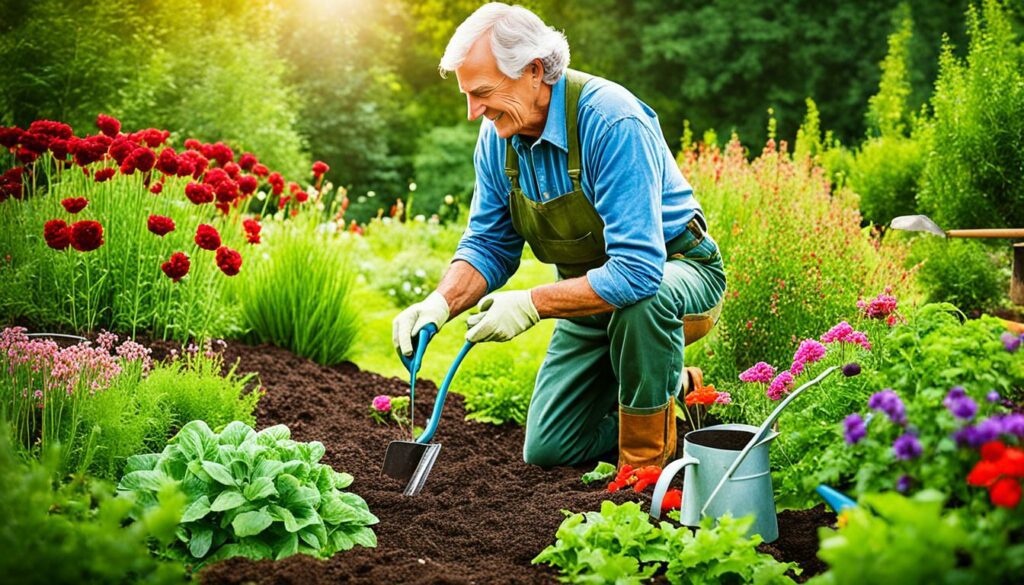
DIY Homesteading Projects
Starting DIY projects is a smart way to boost your skills at home and save money. It doesn’t matter if you have a tiny yard or lots of land. You can find many DIY projects to make your lifestyle more independent and green.
Building raised beds for gardening is a favorite among homesteaders. Raised beds help you grow more, have better soil, and control weeds easier. It’s also a great way to connect with nature. You can use basic carpenry skills to make them from cheap wood or recycled materials.
Making a chicken coop is another key DIY task. Chickens give you fresh eggs, help control pests, and fertilize your garden. By building their coop, you can make it just right for them. With simple tools, making a coop can be both fun and straightforward.
“DIY projects aren’t just about saving money. They’re about learning, having fun, and making your place special. There’s nothing like looking at your property and seeing all the things you’ve done yourself.” – Homesteading Enthusiast
Building a rainwater collection system is another rewarding project. It saves water and makes you less dependent on city supplies. With a few tools and some creativity, you can build a system that fits your needs. You’ll love using free rainwater for your garden!
For those interested in farming at home, making a greenhouse or hoop house is perfect. It lets you grow food all year. A greenhouse gives you control over seed starting, growing fragile plants, and trying new things. It’s a way to take your gardening further and try new eco-friendly methods.
Remember, safety first with DIY projects. Do your homework on the best practices and materials. There are lots of resources online, like homestead DIY project ideas, to help you. Start with easy projects and build your skills gradually.
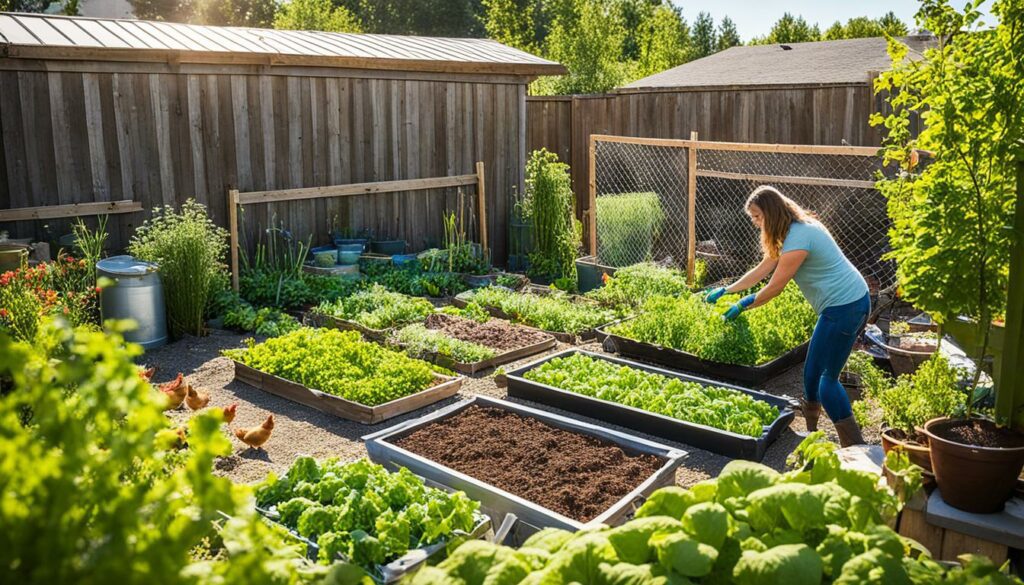
DIY homesteading projects are rewarding. They improve your abilities and make you proud. By living sustainably and enhancing your farming skills, you can make a thriving homestead that fits your life.
Self-Sufficiency in the Kitchen
Mastering kitchen self-sufficiency is vital for any homesteader. By learning how to be self-sufficient, you take charge of your food. This lets you rely less on store-bought items. Here are techniques for sustainable living that boost kitchen self-sufficiency:
1. Meal Planning
Effective meal planning is critical for a self-sufficient kitchen. Planning meals lets you use your resources wisely and cut food waste. Use your garden’s produce and pantry staples for healthy, tasty meals.
2. Cooking from Scratch
Cooking from scratch gives you complete control over meal ingredients. Use fresh garden produce and try making homemade condiments and bread. This approach leads to enjoyable meals and saves money on pre-packaged foods.
3. Preserving Food
Learning to preserve food extends your harvest’s lifespan. Try canning, freezing, and dehydrating fruits, veggies, and herbs. It ensures you have homegrown produce year-round, keeping your kitchen stocked with healthy ingredients.
4. DIY Cleaning Supplies
Make your own cleaning supplies to reduce environmental impact and save cash. Homemade cleaners with vinegar, baking soda, and essential oils are eco-friendly. They also give you control over what’s used in your home.
For more self-sufficiency tips and kitchen guidance, see this article on kitchen self-sufficiency skills at Pantry Paratus.
“Cooking is like love. It should be entered into with abandon or not at all.” – Harriet Van Horne
| Sustainable Living Techniques | Description |
|---|---|
| Composting | Turn food scraps and yard waste into nutrient-rich compost for your garden. |
| Food Preservation | Learn various methods such as canning, pickling, fermenting, and drying to preserve and store food. |
| Seed Saving | Collect and store seeds from your garden to cultivate and grow your own plants in the future. |
| Sustainable Cooking Methods | Explore energy-saving cooking techniques like slow cooking, pressure cooking, and solar cooking. |
Implementing these tips and basics in your kitchen promotes a sustainable lifestyle. Start becoming more self-sufficient by using these methods in your daily cooking routine.
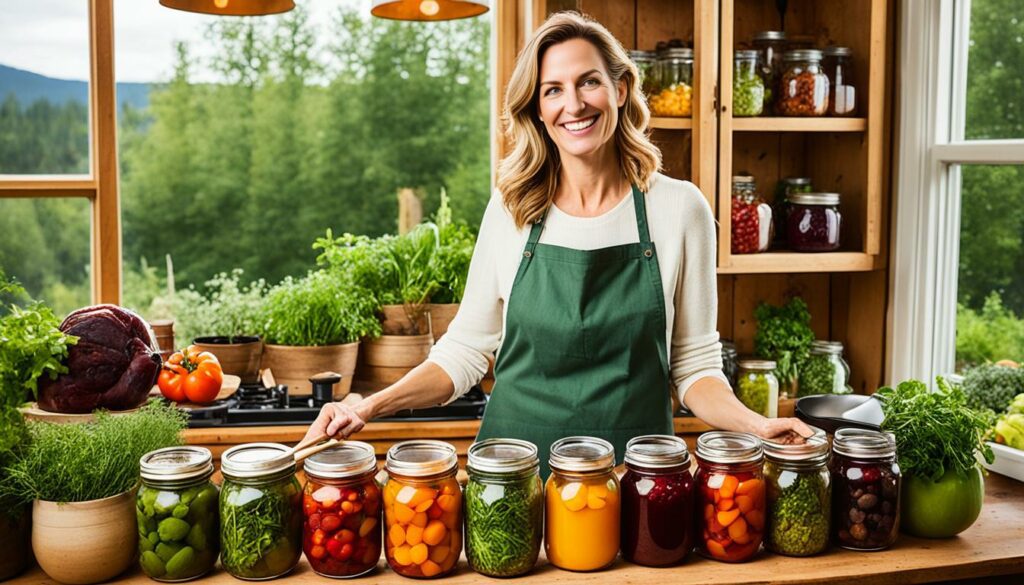
Raising Livestock for Self-Sufficiency
Raising livestock is key for those aiming for self-sufficiency and embracing country living. By acquiring the right skills and knowledge, you can successfully take care of livestock on your homestead. Chickens for eggs, cows for milk and meat, and goats for dairy are just some options. It’s crucial to learn about animal care, providing shelter, nutrition, and basic vet attention.
“Raising livestock is an enriching experience that not only provides valuable resources for your homestead, but also fosters a deep connection to the land and the animals we care for.”
Animal Husbandry and Daily Care
Animal husbandry is about keeping your animals healthy and happy. This includes giving them space to move, access to clean water and good food, and keeping their living areas clean. These steps help prevent disease.
- Find out what specific care your chosen livestock need. Different animals need specific food, living spaces, and health care.
- Buy quality food to make sure your livestock get the nutrients they need.
- Feed them regularly and keep an eye on their health and behavior for any changes.
- Make sure they have shelters for protection against bad weather, predators, and pests.
- Follow a vet-recommended schedule for deworming and vaccines.
Building a Livestock-Friendly Environment
Creating a good environment is vital for your animals’ health and productivity. Keep these tips in mind:
- Build strong fences to keep your animals safe and contained.
- Provide plenty of space for them to graze and move around to prevent overcrowding.
- Set up shaded areas and shelters for protection from the weather.
Veterinary Care and Emergency Preparedness
Even if you can handle basic vet care, it’s important to have a good vet for more serious issues. Also, having an emergency plan is key for your animals’ safety.
Make sure you have:
- A local vet’s contact information who knows how to care for livestock.
- A first aid kit ready with supplies meant for livestock.
- Knowledge of how to perform basic first aid, like treating wounds or giving medications.
- An evacuation plan for natural disasters or unexpected events.
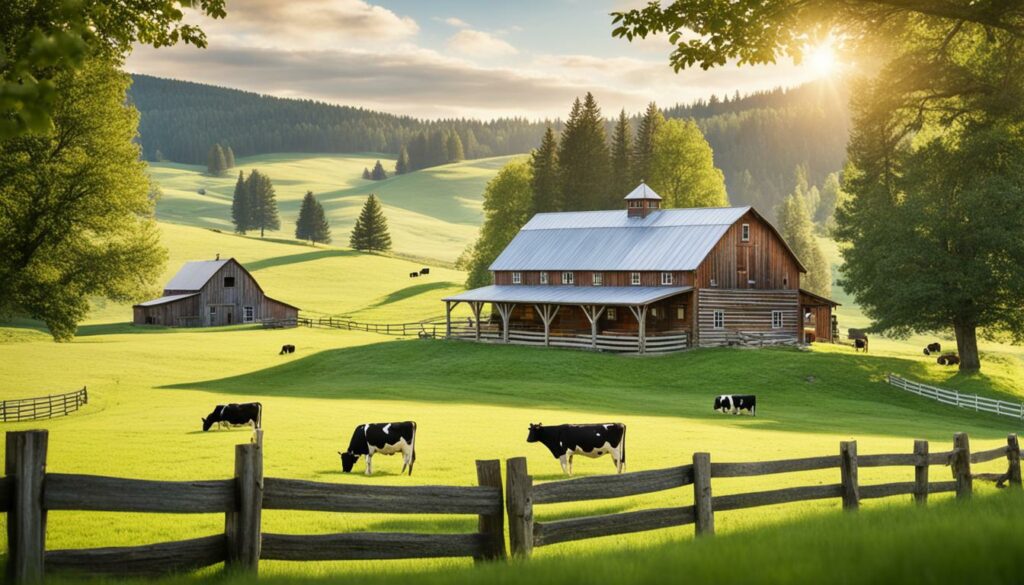
To raise livestock confidently, improve your animal husbandry skills, create a good living environment, and plan for vet care and emergencies. The independence and benefits of producing your own food, fiber, and more are a big part of homesteading.
Homestead Maintenance and Repairs
Keeping a homestead in shape needs regular upkeep and some repairs now and then. You should know a bit about carpentry, plumbing, and how things work. This way, you save both time and money. Learning these skills helps you figure out problems and keep everything running well.
Looking after a homestead means doing a lot of different jobs, big and small. It doesn’t matter if you live without modern comforts or have them, knowing how to take care of things is key. This is how you make sure you can live off your land.
Maintaining the Homestead
Keeping up with maintenance means your homestead works well and stays in good shape. You might need to clean gutters, check electrical stuff, and look over buildings for damage. Tackling these tasks quickly stops small problems from getting worse.
Being organized and knowing what needs to be done helps a lot. A checklist can make sure you don’t miss anything important.
Some usual tasks include:
- Checking and cleaning the chimney
- Trimming trees and shrubs
- Inspecting and repairing fencing
- Maintaining and repairing irrigation systems
- Regularly cleaning and maintaining water sources
Basic Homestead Repairs
Being able to do simple repairs saves money and makes you more independent. Here are some key skills to learn:
- Carpentry: With some carpentry knowledge, you can fix or build things like fences.
- Plumbing: Knowing how to deal with leaks and unclog drains is very useful.
- Electrical: Learning to fix small electrical problems keeps your home safe and working.
- Mechanics: Understanding basic mechanics helps with maintaining small machines, like lawn mowers.
Sometimes, it’s best to call a pro. Knowing when you’re out of your depth can stop things from getting worse.
“Keeping up with maintenance and being able to fix things is crucial for a successful homestead. These skills save money, make you self-reliant, and ensure everything runs smoothly.”
Always put safety first with any job. Follow the right steps, use the proper tools, and get expert help if you need it.
| Common Homestead Maintenance Tasks | Repair Skills |
|---|---|
| Checking and cleaning the chimney | Carpentry skills for fixing structures |
| Trimming trees and shrubs | Plumbing knowledge for fixing leaks or unclogging drains |
| Inspecting and repairing fencing | Electrical skills for troubleshooting issues |
| Maintaining and repairing irrigation systems | Mechanical knowledge for handling small engine repairs |
| Regularly cleaning and maintaining water sources |
Preserving and Using Homestead Resources
Homesteaders are skilled at making the most with what’s around them. They grow their own food and raise animals. They also know how to save and use everything from their land. Let’s look at ways to preserve and store food and other resources.
Preserving Food for Sustenance
For homesteaders, preserving food is key. It lets them enjoy their harvests all year. One popular way is canning. This method involves putting food in jars and boiling or pressure canning them. Check out this canning guide for help.
Freezing is another way to keep food. You can freeze fruits, veggies, and sauces. Blanch certain veggies to keep them fresh. Remember to label your frozen foods!
Dehydrating is another great method. It removes moisture from food, making long-lasting snacks and spices. Use a dehydrator or an oven on low for this.
Utilizing Homestead Resources Creatively
Homesteaders use what they have in creative ways. They make homemade cleaning products from simple stuff like vinegar and baking soda. These are cheaper and better for the environment.
Making soap is cool too. With lye, oils, and water, you can make soaps that fit your needs. Try different scents and add-ins to customize.
They also make personal care products. Things like lip balm and salves can be made from garden herbs and oils. This means no harmful chemicals.
Embracing Resourcefulness in Homesteading
Homesteaders are like alchemists, making valuable and sustainable things from their resources.
Homesteading is more than living off the land. It’s about using what you have wisely. By preserving food and being creative, you lower waste and save money. This lifestyle is all about self-reliance.
In the next section, we’ll look at building communities and bartering. This also helps homesteads stay sustainable. Learn more about it here.
| Benefits of Preserving and Utilizing Homestead Resources | Preservation Techniques | Resourceful Homestead Products |
|---|---|---|
| Reduces food waste | Canning | Homemade cleaning products |
| Extended availability of fresh, homegrown food | Freezing | Homemade soaps |
| Cost-effective | Dehydrating | Personal care items |
| Increases self-sufficiency |
This table shows the benefits of saving and using homestead resources. It covers different techniques and products.
Building Community and Bartering
Homesteading is not just about self-sufficiency. It’s also about building a sense of community. Knowing your neighbors and others with similar interests can offer both support and opportunities to learn and share skills.
Collaborating with others helps you build a strong network. This network can support you and help create a thriving homesteading community.
Meeting fellow homesteaders through local meetups or workshops is a great idea. These events are perfect for sharing knowledge and experiences. They help you learn about different homesteading practices and make valuable connections.
Having a community of like-minded people can make rural living better. Being part of a group that shares your values offers a sense of belonging. Whether through working together, undertaking group projects, or sharing meals, these connections enhance your homesteading journey.
Bartering plays a key role in community building. It involves swapping labor and resources to fulfill each other’s needs. By bartering, you can diversify your resources without depending on outside sources.
Building community and bartering leads to trust and cooperation. This creates a win-win where everyone benefits from shared skills and resources. This leads to a resilient and interconnected community.
Benefits of Building Community and Bartering
Building a homesteading community and bartering has many benefits:
- Sharing knowledge and skills: Connect with others to learn from their experiences. Workshops and projects are great ways to expand your knowledge and skills.
- Resource diversification: Bartering gets you resources that might be hard to find. This way, you can get what you need without relying only on outside sources.
- Economic savings: By bartering, you can save money. Trade your goods or skills to get what you need without using cash.
- Building strong relationships: Talking and working with fellow homesteaders can lead to friendships. These bonds can help you face the challenges of rural living.
- Emotional support: A supportive community offers encouragement. Knowing you have people to turn to can make a big difference when faced with challenges.
By joining in community building and bartering, you enhance your homesteading life. Remember, homesteading means coming together to support one another towards a resilient, harmonious life.
| Benefits of Building Community and Bartering | Homesteading Basics | Rural Living Essentials | Off-Grid Living Skills |
|---|---|---|---|
| Sharing knowledge and skills | |||
| Resource diversification | |||
| Economic savings | |||
| Building strong relationships | |||
| Emotional support |
Conclusion
Developing homestead skills is a journey that requires dedication. It needs a willingness to learn. Mastering gardening, DIY projects, and self-sufficiency in the kitchen help individuals thrive.
Homesteading involves many skills. These skills empower people to live sustainably and use fewer outside resources. This lifestyle includes a wide range of abilities.
Homesteading lets people grow their own food and start DIY projects. It helps improve self-sufficiency. By saving and wisely using resources, people can save money and lessen waste.
Raising animals and caring for a homestead creates a strong bond with the land. It also supports a sustainable way of living. This approach is more connected to nature and life.
Homesteading is about being self-sufficient and building a community. By connecting with neighbors and other homesteaders, people can share knowledge and resources. This sharing strengthens community bonds and shared experiences.
Enjoy the journey of homesteading and its benefits. There’s always something new for both beginners and experts. By improving your skills, you help the environment and your community. And you create a sustainable future.
FAQ
What is homesteading?
Homesteading is a lifestyle that focuses on self-reliance and living sustainably.
What skills do I need for homesteading?
You’ll need skills like gardening and doing DIY projects. Knowing how to cook and fix things is also key.
How do I get started with homesteading?
Start by learning about homesteading and sustainable living. Also, understand how to manage a homestead.
What are some homestead gardening strategies?
Use container gardening, plant companions, and know your zone. This helps your garden thrive.
What kind of DIY projects can I do on a homestead?
You can build raised beds or a chicken coop. These projects boost your skills and save money.
How can I practice self-sufficiency in the kitchen?
Learn to plan meals, cook from scratch, and store food. Canning, freezing, and drying foods are good methods.
What skills do I need for raising livestock on a homestead?
Learn about caring for animals, basic vet skills, and how to feed and shelter them properly.
How can I maintain and repair my homestead?
Gain basic carpentry, plumbing, and mechanical skills. These will help you keep your homestead in good shape.
How can I utilize and preserve resources on my homestead?
Make your own cleaning and personal care items. Also, preserve food by canning, freezing, and drying.
How can I build community and engage in bartering as a homesteader?
Connect with others who share your interests. By trading labor and resources, you help each other out.
This website contains affiliate links. Some products are gifted by the brand to test. As an Amazon Associate, I earn from qualifying purchases. The content on this website was created with the help of AI.
